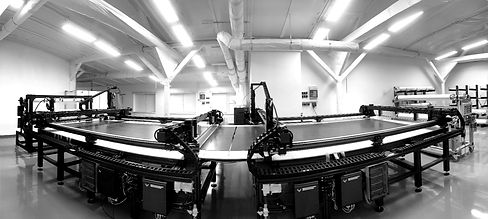Technology
Production
The product went through various iterations
-
considering the extensive feedback of future users and hygienic experts and
-
to solve the technical challenges in the manufacturing process.
Since no supplier was able to produce SURGITENT to the required specifications it was decided to take all product related manufacturing processes in house. A clean room production site was established in northern Germany and 3 production machines were designed and custom- built to SURGITENTs specification.


History
Since 2015 two companies are in a race to bring the best mobile OR to market: SurgiBox out of Boston, MA and SURGITENT out of Hamburg. Both are based on the early works of J.A. Reyniers from 1939: He invented the first sterilizable metal isolator. Its large size and weight made it inflexible and by the end of the 1950’s a lightweight, PVC-based version was established. After the invention was introduced to operating rooms the Trexler isolator (named after Reyniers' assistent) became increasingly smaller, and cheaper, to fit its new environment.
But when in the late 20th century potent antibiotics and advanced ventilation and air-filtering systems became widely available the Trexler isolator was slowly replaced. Especially, its need for electricity-powered pumps and complex filter technology made the surgical isolator an inconvenient tool.
Today, in response to a rising need for clean operating environments, and the increased risk for infectious diseases SURGITENT takes the crucial next step to bringing surgical isolation back into modern-day operating rooms. Backed by over 80 years of history, we understand that only disposable, non-powered isolators with simple yet effective air filtration systems can tackle the challenge of safe and simple surgery.
1943
Trexler and Reynier:
Development of the first surgical isolator. to obtain gnotobiotic (germ-free or infected with defined microbiotes) mammals
-
Isolator made of stainless steel. Steam sterilized
-
At the bottom of the isolator there is a gap covered with a thin transparent plastic film
-
Mother's abdomen is placed against the sterile exterior of the plastic film
-
Incision is made through the plastic film and the underlying skin using cautery
-
The mammal born in the germ-free environment is transferred through a valve into a new sterile steel isolator for rearing
1957
1958
1973
Trexler and Reynolds:
Development of an isolator from a transparent flexible plastic film
Trexler:
Use of the isolator for patient care, particularly with regard to performing operations in a closed environment
-
Made from a flexible polyvinyl chloride (PVC) plastic film disinfected with a peroxyacetic acid spray
-
Filled with air that was purified by a HEPA filter and exited through a disposable system•
-
Necessary instruments and supplies were sterilized and introduced into the isolator
-
Controlling temperature, humidity and composition in the insulator
-
Advantage over conventional operating rooms: X-ray machines (a potential source of wound contamination) could remain outside the isolator and therefore shielded from the patient
Trexler [1]:
Development of a flexible plastic isolator, which consists of an adhesive surgical drape on the underside (stuck to the patient's skin)
-
Surgical team works in a “half suit”
-
The inside of the isolator is independent of the rest of the room, which no longer needs to be kept sterile
-
Rigorous extra measures and necessary discipline of the operating room staff are no longer necessary
-
Several operations can therefore take place in the same room
1974
McLauclan [2]:
Clinical use of Trexler's surgical isolator for hip surgery.
1991
Marlin [3]:
Introduction of Surgical Isolation Bubble System (SIBS) use in ventriculoperitoneal shunts.
1996
James [4]:
Last known publication of clinical data, before the SIBS production was discontinued.
References:
[1] Trexler PC. An isolator system for the maintenance of aseptic environments. Lancet. 1973 Jan 13;1(7794):91-3. doi: 10.1016/s0140-6736(73)90481-9. PMID: 4118663
[2] McLauchlan J, Pilcher MF, Trexler PC, Whalley RC. The surgical isolator. Br Med J. 1974 Feb 23;1(5903):322-4. doi: 10.1136/bmj.1.5903.322. PMID: 4819158; PMCID: PMC1633349.
[3] Marlin AE, Gaskill SJ (1991) The use of the surgical isolation bubble in ventriculoperitoneal shunts . In: Marlin AE (ed) Concepts in pediatric neurosurgery, vol 11. Karger, Basel, pp 47-53
[4] James HE, Murphy KG. The Surgical Isolation Bubble System and patient temperature during ventriculoperitoneal shunt insertion in preterm and term newborn infants. Childs Nerv Syst. 1998 Jan-Feb;14(1-2):26-9. doi: 10.1007/s003810050169. PMID: 9548336.